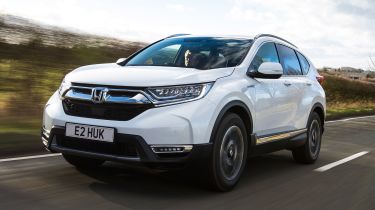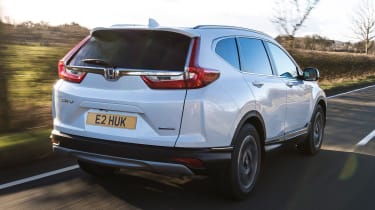Honda CR-V (2017-2023) review
Practical, comfortable and well-equipped, the Honda CR-V makes sense as a family SUV, although overall efficiency could be better

A significant number of changes have improved the Honda CR-V and its breadth of ability. There’s a sharper driving experience, increased space for passengers and better interior quality which have been added to the last car’s already impressive levels of practicality and reliability.
The lack of a diesel option is becoming less important by the day, although the CR-V's increased price tag may deter some buyers as Honda attempts to move the model upmarket to rival more premium compact SUVs. However, as a complete package, the CR-V is an impressive and highly capable car. It’s perfectly suited to family duties and is highly likely to be satisfying to own, too.
About the Honda CR-V
The Honda CR-V was one of the first compact SUVs for sale when the first generation arrived in 1995. Since then it has been a hugely popular model around the world, although in the UK it hasn’t quite had the level of success that it’s achieved in other markets.
The fifth generation model arrived in 2018. And while the CR-V looks relatively similar to the outgoing model, underneath the skin it has a number of significant changes, including a hybrid drive system and updates that push it into contention with more premium rivals.
Used - available now
Honda’s commitment to hybrid powertrains means there’s no diesel and, as of late 2020, the hybrid is the only option; a turbo petrol was also available before this. Rivals include the Toyota RAV4, Hyundai Tucson, Ford Kuga and the Nissan Qashqai although, unfortunately, Honda’s effort is less economical than any of these cars.
The 1.5-litre turbocharged four-cylinder VTEC petrol unit came with 171bhp in entry-level guise and was matched to a six-speed manual gearbox with front-wheel-drive. This engine could also be had with 190bhp, and this came with a CVT gearbox and four-wheel-drive as standard. The CR-V Hybrid combines a 143bhp 2.0-litre naturally aspirated petrol engine with an electric motor and is available in two- or four-wheel-drive versions.
The CR-V’s wheelbase has been increased over the last model. This provides greater interior space to the point where it can now be specified with seven seats rather than five. The extra row of seats are cramped, though and are only really suitable for children however, but these extra seats still give the CR-V an advantage over some rivals which are strictly five-seater only. The downside is that the boot in this fifth-generation model is actually smaller than before, although it still offers 497 litres with the seats in place and up to 1,692 litres with all the seats folded, making it very generous if not one of the largest in the segment.
Honda is seeking to push the CR-V upmarket, so there are higher-grade materials used in the cabin and high levels of standard equipment. Prices start from around £32,000 (the discontinued petrol versions were slightly cheaper), and with the top-of-the-range EX models nudging around £41,000, the CR-V is now in competition with premium SUVs like the Land Rover Discovery Sport and Volkswagen Tiguan, as well as cars like the Peugeot 3008 and SEAT Ateca.
In fact, the compact SUV class is so tough these days that the CR-V also faces opposition from the Skoda Karoq, Citroen C5 Aircross, Vauxhall Grandland, Mazda CX-5, Kia Sportage and the Renault Kadjar, too.













